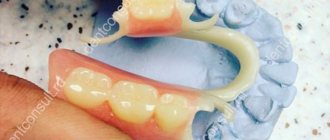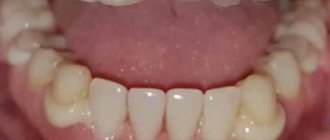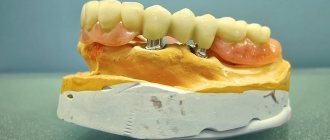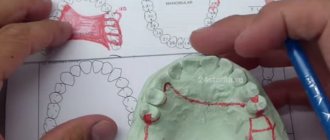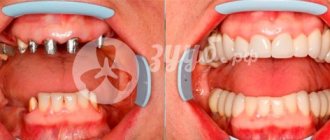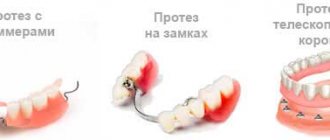Dental prosthetics are necessary in cases where it is not possible to install crowns - replacements for lost molars. There are different types of dentures, but the most reliable is the clasp denture with locks.
The locking type of clasp prosthesis is an improved design of its predecessor, the clasp-based prosthesis. Clasps are special hooks that cling to healthy teeth, which serve as a support for the prosthesis. The main disadvantage of clasps, which contributed to the development of a new type of fastening, is that they are noticeable to an outside observer, regardless of how deep the dentures are located in the oral cavity.
As you can already guess from the name, the locking type of prosthesis is secured using special locks. Each lock consists of two interlocking halves: one is attached to the prosthesis itself, and the other is attached to a special crown, which is put on the supporting healthy tooth. When installing a prosthesis, these parts of the same design tenaciously grip each other, which guarantees reliability in its fixation in the oral cavity.
When you decide to install a clasp prosthesis with locks, your doctor can recommend several types of fastening:
- Conventional locking - the supporting teeth are ground down and special crowns with a part of the locking fastening are put on them.
- Attachment - part of the lock is inserted directly into the tooth without preliminary filing, leaving it in its original form, the fastening is located inside the prosthesis and when installed, the prosthesis looks most natural.
- Telescopic - crowns of a special cone shape are installed on the supporting teeth, onto which a prosthesis is then placed, which has similar recesses in the structure at the attachment points.
The need to install a clasp prosthesis with locks is determined by the following problems:
- in the absence of three or more teeth in a row, and there is no difference between frontal and posterior teeth;
- if it is impossible to install another type of prosthesis;
- with defective dentition;
- with disorders of chewing function;
- with malocclusion;
- with a tendency to bruxism, due to which the teeth are severely worn down;
- in case of impaired diction due to lost teeth.
Clasp prosthesis with locks requires an individual approach in manufacturing, since there are no standard designs, which is due to its rather high cost. Each product is the fruit of the joint work of the attending dentist, orthopedist and dental technician. First, a cast of the jaw, upper or lower, is made, then the dental technician makes a plaster copy, and after all the necessary fittings and clarifications, the clasp prosthesis is cast. After this, a decision is made which type of locking connection will be preferable, based on both the opinion of the patient and the opinion of the attending physician. Before making metal parts (an alloy of chromium, molybdenum and cobalt or stainless steel is used), it is checked whether the patient is allergic to the source material. If there is, then the base is made from special heat-resistant plastic.
What is a clasp prosthesis?
Clasp dental prosthetics is a widely used treatment method in orthopedic dentistry. Designed to restore teeth in both the lower and upper jaws. The name itself comes from the German “bugel”, which means “arc”, that is, bugel - literally “having an arc”. The design of clasp dentures includes a metal or plastic arch, artificial teeth that are attached to a base that imitates gums, and fixing elements in the form of hooks, clasps or crowns.
By mounting method
In modern dentistry, various means of fixation are used. The comfort and duration of getting used to the structure will depend on the chosen method and quality of fastening. The orthopedic surgeon selects specific methods of fixation taking into account the individual clinical situation and the chosen method of prosthetics.
Creams and powders are considered one of the more reliable means of fixing removable dentures. A special product is applied to the denture, which is then pressed tightly to the oral cavity. Creams are recommended for patients with increased salivation, and powders are used for low salivation. If the structure of the jaw is abnormal, orthopedic doctors recommend using fixing strips.
Clasp-type dentures are secured using attachments or clasps. Alveolar processes are also used, which provide additional fixation. When putting on a removable denture, reliable fastening provides a suction effect.
Stages of making a clasp prosthesis
Based on the principle of making the frame, the clasp prosthesis is divided into several types: soldered, solid-cast, milled, and based on laser sintering of nanoparticles of a special metal alloy powder. The last two methods are considered the most progressive and allow you to create a high-precision (up to 10 microns) and comfortable design.
Manufacturing takes place in 4 stages:
- first the dental technician creates a plaster model
- Based on the plaster model, a prototype of the prosthesis is cast and scanned
- using the scan, the frame of the clasp structure is modeled on a computer
- the prosthesis is ultimately sintered or milled.
The result exceeds all expectations - the prosthesis fits tightly to the gums and teeth, does not break and looks very aesthetically pleasing.
Expert opinion
Roman Borisovich Alekperov
orthopedic dentist
Experience: 24 years
The attachments are located so discreetly that others will not see that there is something wrong with your mouth, for example, as with a clasp type of fixation. Therefore, for patients who are concerned about aesthetics, I always recommend clasp dentures with locks. They snap on easily and are easy to remove. The prosthesis is securely held in the mouth, it is comfortable to wear, and the product itself is repairable. In any laboratory you can quickly replace the necessary part. This versatility is a big advantage in this case. But if the hooks on the clasp are broken, the situation is more complicated; in most cases, a new prosthesis will have to be made.
Indications for clasp prosthetics
The main indication for clasp dentures is the inability to install dentures on implants and the presence of at least several supporting teeth to which it could be secured. Partial structures are most often used both to replace several teeth with terminal defects and to restore a single tooth.
Whereas the clasp upper and lower denture completely reproduces the entire dentition. In addition, there is a splinting clasp prosthesis, which is used as a structure that restores and supports teeth. The prosthesis splints teeth affected by periodontitis or periodontal disease from the inside, replaces missing parts of the dentition and prevents the occurrence of adentia and prolongs the performance of the affected teeth.
Contraindications include:
- oral diseases in the acute stage
- increased tooth wear
- diseases leading to bone loss
- low or missing abutment teeth
- deep bite
- chronic neurological and mental diseases
- short frenulum of the tongue
- shallow floor of the mouth
- allergy to metal or other materials used in the design
Prosthetics on implants
Removable prosthetics on implants is a modern technology that has a number of undeniable advantages. The aesthetics of implant prosthetics are impeccable; you don’t have to worry about others noticing that your teeth are artificial, much less that the prosthesis will fall out during an active conversation or while eating. In addition, the technology allows you to achieve complete restoration of all functions of lost teeth .
Implant prosthetics is the most expensive type of restoration of lost teeth and involves a long treatment consisting of several successive stages:
- Diagnostics and preparation. During diagnostic measures, the condition of the patient’s jaw bone is assessed, and existing problems in the oral cavity are identified. If necessary, treatment of dental diseases, osteoplasty, and sanitation of the oral cavity are carried out;
- The surgical stage during which dental implants are implanted into the bone tissue;
- There is a pause in the treatment process necessary for the implantation of artificial roots and restoration of tissue damaged during surgery. The progress of osseointegration of implants is constantly monitored, and only when the rod has fused with natural tissue can the final stage of treatment begin;
- Crowns or solid dentures are placed on the implants.
The price of prosthetics on implants will depend on what surgical technique will be used, on the type of implantation system, the need for preliminary treatment and bone grafting, as well as the material used for the production of crowns. Different types of prostheses can be installed on implants, but it is best to choose structures made from high-quality and durable materials - ceramics, zirconium dioxide. The stronger and more reliable the prosthesis, the longer its useful life will be.
Single crowns and bridges are also used in implant prosthetics. The prosthesis is secured to the implant using special fasteners, which can be:
- Globular. Used when it is necessary to implant a small number of implants;
- Beam. Used when installing solid dentures on implants.
A removable denture on an implant can also be secured with a screw. This fastening technology makes it possible to restore the dentition without implanting artificial roots under each crown. To restore all elements of the dentition, four to six dental implants may be sufficient (all-on-four or "all at six")
Naturally, you cannot remove a prosthesis placed on implants yourself; to remove the crown, you will have to visit a doctor’s office. Therefore, this method of restoration is often called conditionally removable prosthetics.
Advantages of the technology:
- The ability to install and properly fix a crown or prosthesis even in the complete absence of dentition elements;
- There is no need to depulp healthy teeth or grind them down, which leads to their weakening and increased fragility;
- Prosthetics on implants does not cause disturbances in diction and other unpleasant side reactions that patients have to deal with during the adaptation period;
- The technology eliminates the processes of bone tissue atrophy.
Implant restorations have a solid longevity. The useful life of implants is at least 20-25 years, and manufacturers provide a lifetime guarantee for premium systems.
Types of clasp dentures
Clasp dentures are also divided according to the method of their attachment to the supporting teeth. Unlike completely removable structures, which are fixed by suction to the gum or using special adhesives, fixation and installation of clasp dentures occurs using several types of fastening.
On clasps
Clasp dentures with clasps consist of metal hooks that clasp the abutment tooth in the neck area. The clasp clasp prosthesis is attached without grinding down the enamel, provided that the supporting teeth are not destroyed or affected by severe caries. However, this type is not aesthetic enough - the hooks are noticeable when you smile.
On locks or attachments
A locking clasp prosthesis consists of two parts, one of which is attached to the ground abutment teeth, and the second with the help of locks to the prosthesis itself. Unlike other types, a clasp denture with attachments is more immobile, so the load is distributed evenly on the supporting teeth and the alveolar mucosa.
Clasp prosthesis on telescopic crowns
When installing a clasp prosthesis on telescopic crowns, first fixed metal crowns are placed on the supporting teeth, and then ceramic crowns are placed in the prosthesis.
Acry-free removable prosthetics systems
“Acry-free” is the name given to soft removable dentures of a new generation, made from an innovative material - acrylic resin with the addition of components that give the structure strength and ensure the hypoallergenicity and biocompatibility of the prosthesis.
“Acry-free” are highly elastic soft removable dentures and therefore patients often think that they are no different from ordinary nylon products. But this is not so: in terms of strength, reliability and aesthetics, Acri Free prosthetic systems are far ahead of their nylon counterparts.
“Acry-free” prosthetics are advisable in the following cases:
- The patient is diagnosed with an allergy to polymers, metals and their alloys;
- To eliminate complete edentia, carry out partial restoration;
- With diagnosed periodontitis. Installation of removable dentures “Acry-free” will help stop the process of loosening of teeth and prevent their loss.
“Acry-free” is one of the best options for dentures for people involved in traumatic sports. The advantages of Acri Free removable systems definitely include the possibility of their use in periodontal diseases, which are a contraindication to classical prosthetic options.
Unlike analogs made of nylon and acrylic, the installation of “Acry-free” removable dentures makes it possible to achieve a high-quality fit of the structure to the tissues of the oral cavity, which eliminates pain during use of the product and impaired diction. To install Acri Free, no grinding of healthy teeth is required, the prosthesis does not sag on its bed even with prolonged use, and does not become stained from contact with food. The high tightness of the fit and the quality of the production material guarantee that pathogenic microflora will not penetrate under the prosthesis.
The main disadvantages of “Acry-free” dentures are the high cost (from 13,500 rubles and above), as well as the impossibility of obtaining the correct distribution of the chewing load during operation. However, we note that the same disadvantage is inherent in all types of removable dentures, and the correct operation of the chewing muscles can only be provided by installing fixed structures and performing prosthetics on implants.
Nylon clasp quadrotti prosthesis
A product of the Italian company Quattro Ti, the quadrotti clasp prosthesis is very similar to a removable nylon prosthesis, with the only difference being that during its manufacture, nylon is mixed with hypoallergenic plastic. The resulting material has a number of advantages: it is more durable than nylon, and artificial teeth do not show through it. According to the manufacturers, this type of metal-free clasp prosthesis does not deform over time, does not cause discomfort when worn, and looks much more aesthetically pleasing than other prostheses. A soft prosthesis is attached to the teeth using plastic clasps, or saddles, covered on top with the same material as the base of the prosthesis. Saddles can be either pink or white, making them unnoticeable on the teeth. As for the disadvantages of the prosthesis, firstly, Quattro Ti is not strong enough, since no matter how strong the plastic is, it cannot be compared with metal. Secondly, a clasp prosthesis with nylon saddles requires special care using special means, which requires additional costs and cannot be repaired.
Properties and characteristics of removable dentures made of different materials
For the manufacture of removable dentures, the following can be used: acrylic plastic, nylon, and unique polymer compositions. As noted above, the raw materials used to manufacture the structure will have a significant impact on the properties and performance characteristics of the finished product. Below we will describe in detail the features of prosthetic systems made of different materials.
Caring for clasp dentures
Getting used to the clasp denture may take a couple of days. At first it will be somewhat uncomfortable for you to talk, so you will have to get rid of speech defects with the help of special exercises. Eating will also cause some difficulties. At first, to minimize pain, it is best to divide food into small portions and exclude very hard foods and sticky sweets from the diet. In order to quickly get used to the prosthesis, do not take it off at night.
Twice a day (morning, evening) it is necessary to remove the clasp prosthesis and clean it of plaque using the means recommended by the doctor, and also rinse it in a special antibacterial solution.
The clasp denture should be stored in a container, but not in water. Some types of structures, for example, soft quadrotti dentures, require special care, otherwise they fade and look unsightly on the teeth.
Advantages of attachments over clasps
Clasps are the simplest supporting and holding structures. In its simplest form, it is a bracket that covers the abutment tooth. The advantages of clasps include simplicity of design and low cost. However, functionally they are inferior to attachments, which have the following advantages in comparison with them.
- Reliable fixation.
- More apical application of force.
- Standardization of parts (allows you to quickly replace a failed element).
- Possibility of repair, activation and wear monitoring.
Advantages and disadvantages
For comparison, let’s take the clasp’s “classmates” - fixed bridges and removable plate prostheses. Clasp orthopedic structures, of course, are superior to plate ones in strength, but, like bridges, they are a temporary way to restore the dentition. Despite all the efforts of manufacturers, the clasp is not able to stop the loss of bone tissue, the inevitable decrease of which soon leads to changes in facial features and disturbances in the functioning of the dental system and internal organs. The obvious disadvantages of a removable clasp also include an aesthetic defect when installing a clasp prosthesis, when metal hooks attached to the teeth are visible, and a slow adaptation time to the design. In addition, any denture puts pressure on the gums and causes discomfort when chewing and hypoxia - a condition in which the gums do not have enough nutrition, which causes bone tissue to atrophy even faster. As for the service life of clasp dentures, compared to dental implants, it is quite short and is no more than 10 years. Subject to proper care and timely correction once a year.
Design Features
The clasp prosthesis is based on a metal frame. It is cast, which ensures sufficient structural strength. A pink plastic or nylon plate is welded to it. Artificial crowns are attached to it, replacing teeth for patients. The design is durable, but temporary and requires periodic replacement. The wearing time depends on the materials used and the quality of workmanship.
Clasp structures are best suited for upper jaw prosthetics. They do not cover the palate, so they are comfortable to wear. Despite the metal frame, the dentures are not felt when chewing and speaking and do not cause discomfort.
The process of creating a prosthesis
An ideal fit and the most comfortable wearing are ensured only by an individual approach to creating a prosthesis. Therefore, at the Beryozka clinic they are made according to a personal impression. It is removed in the dentist's chair using alginate or silicone. The material is placed on a special spatula, which is pressed against the teeth. You need to spend a few minutes in this state. The impression hardens and is easily removed from the jaw. The resulting cast is sent to the workshop to make a custom prosthesis.
In a dental workshop, the creation of a clasp denture goes through several stages:
- Casting a plaster model of the patient’s jaw and drawing the shape of the future prosthesis on it.
- Formation of the structure frame, its grinding and polishing.
- Creating the shape of the prosthesis from wax, choosing the shade of future crowns and installing them in a temporary model.
- Trying on the temporary structure by the patient, clarifying small details.
- Casting of a permanent product from plastic or nylon, final polishing and grinding.
- Final correction of the prosthesis in the patient's mouth.
When the design is finally ready, the doctor explains the features of its wearing and care. The patient is scheduled for a follow-up appointment to monitor the condition of the prosthesis and healthy teeth.
How much does partial denture cost?
The average cost of clasp dentures in Moscow consists of the cost of the material, the work of the dental technician and the method of attachment to the supporting teeth. So, despite their popularity, the cost of nylon quadrotti dentures for one jaw is approximately the same as the price of clasp dentures - from 45,000 rubles and more. Clasp dentures with locks are somewhat more expensive - from 35,000 to 80,000 rubles. The most expensive of removable structures are considered to be dentures with telescopic crowns - their price ranges from 100,000 rubles to 200,000 rubles and more. As for clasp dentures on implants, their cost starts from 90,000 to 200,000 rubles and more, depending on the number of implants installed. If you decide to have a clasp prosthesis installed, then choose trusted clinics here.
High-quality clasp prosthetics is a worthy alternative to implantation, and in times of economic depression, clasp prosthetics is the most optimal option for restoring missing teeth.
Constructions using telescopic crowns
This option of prosthetics is considered quite popular in Western countries, but the above-mentioned clasp dentures are not popular in Moscow and other cities of the Russian Federation. The essence of the technique is as follows: initially, the supporting units are prepared, then metal caps are placed on them. A special cement composition is used to fix the orthopedic product.
As a rule, the above metal caps serve as supports for crowns located on the clasp and connected to the metal base of the structure. This fastening method promotes strong fixation of the prosthesis, allows for optimal distribution of the chewing load, provides the necessary aesthetic effect and has more reasonable prices compared to products with clasps.



